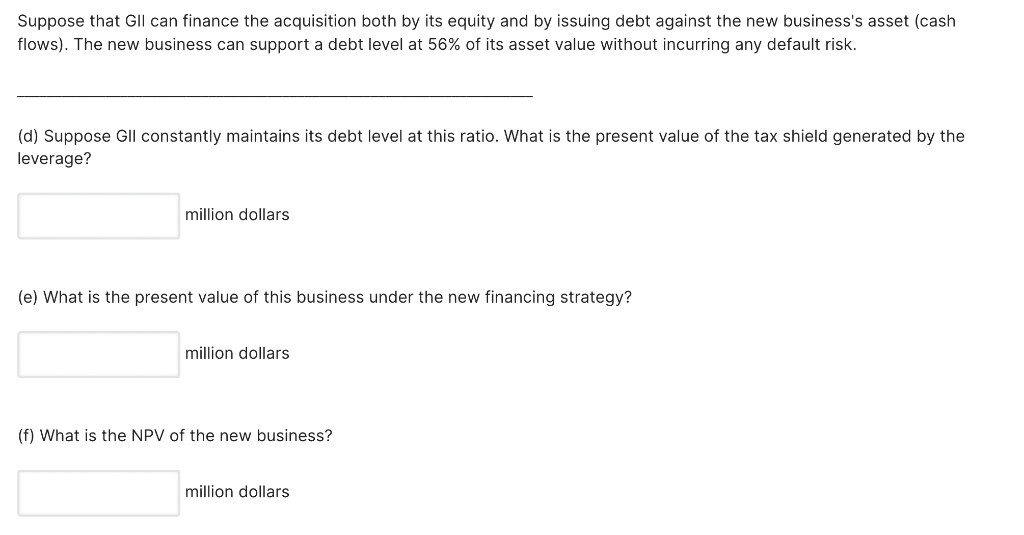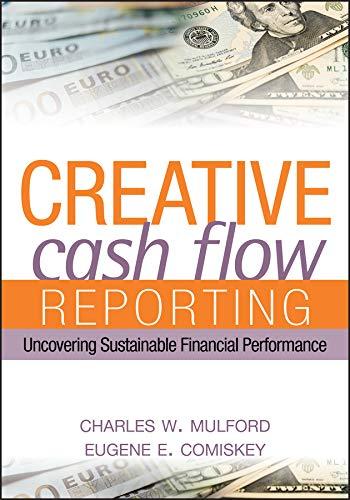



Global Industries Inc. (GII), a US conglomerate, has a debt-to-equity ratio of 0.3 and a WACC of 10%. At this level of leverage, Gil's debt is risk-free and it constantly rebalance its debt to maintain a constant debt-to-equity ratio. Assume CAPM holds, the risk-free interest rate is 4.0% and the risk-premium on the market portfolio is 5%. Gli faces a corporate tax rate of 30%. Gil is considering acquiring a new business, which has a market beta of 1.1. The new business yields an annual expected after-tax cash flow of $10 million forever, starting next year (year 1). The acquisition cost is $107.6 million. Suppose that Gil finances the acquisition by all equity, e.g., by issuing equity in the new business. (a) What is the cost of capital for the new business (its asset)? % (b) What is the present value of the new business's asset, i.e., the PV of its future cash flows. million dollars (c) What is the NPV for acquiring this new business, with 100% equity financing? million dollars Suppose that GlI can finance the acquisition both by its equity and by issuing debt against the new business's asset (cash flows). The new business can support a debt level at 56% of its asset value without incurring any default risk. (d) Suppose GIl constantly maintains its debt level at this ratio. What is the present value of the tax shield generated by the leverage? million dollars (e) What is the present value of this business under the new financing strategy? million dollars (f) What is the NPV of the new business? million dollars (g) Under the capital structure for the acquired business described in Parts D-F above, what is its current value of debt? million dollars (h) Under this capital structure for the acquired business, what is its current value of equity? million dollars (i) What is the WACC of this newly acquired business? % (i) What is the present value of this new business based on its after-tax cash flow and WACC? million dollars (k) If Gll can use its existing assets to borrow money at the risk-free rate to finance part of the acquisition, would it make the deal more attractive? Yes No Global Industries Inc. (GII), a US conglomerate, has a debt-to-equity ratio of 0.3 and a WACC of 10%. At this level of leverage, Gil's debt is risk-free and it constantly rebalance its debt to maintain a constant debt-to-equity ratio. Assume CAPM holds, the risk-free interest rate is 4.0% and the risk-premium on the market portfolio is 5%. Gli faces a corporate tax rate of 30%. Gil is considering acquiring a new business, which has a market beta of 1.1. The new business yields an annual expected after-tax cash flow of $10 million forever, starting next year (year 1). The acquisition cost is $107.6 million. Suppose that Gil finances the acquisition by all equity, e.g., by issuing equity in the new business. (a) What is the cost of capital for the new business (its asset)? % (b) What is the present value of the new business's asset, i.e., the PV of its future cash flows. million dollars (c) What is the NPV for acquiring this new business, with 100% equity financing? million dollars Suppose that GlI can finance the acquisition both by its equity and by issuing debt against the new business's asset (cash flows). The new business can support a debt level at 56% of its asset value without incurring any default risk. (d) Suppose GIl constantly maintains its debt level at this ratio. What is the present value of the tax shield generated by the leverage? million dollars (e) What is the present value of this business under the new financing strategy? million dollars (f) What is the NPV of the new business? million dollars (g) Under the capital structure for the acquired business described in Parts D-F above, what is its current value of debt? million dollars (h) Under this capital structure for the acquired business, what is its current value of equity? million dollars (i) What is the WACC of this newly acquired business? % (i) What is the present value of this new business based on its after-tax cash flow and WACC? million dollars (k) If Gll can use its existing assets to borrow money at the risk-free rate to finance part of the acquisition, would it make the deal more attractive? Yes No










